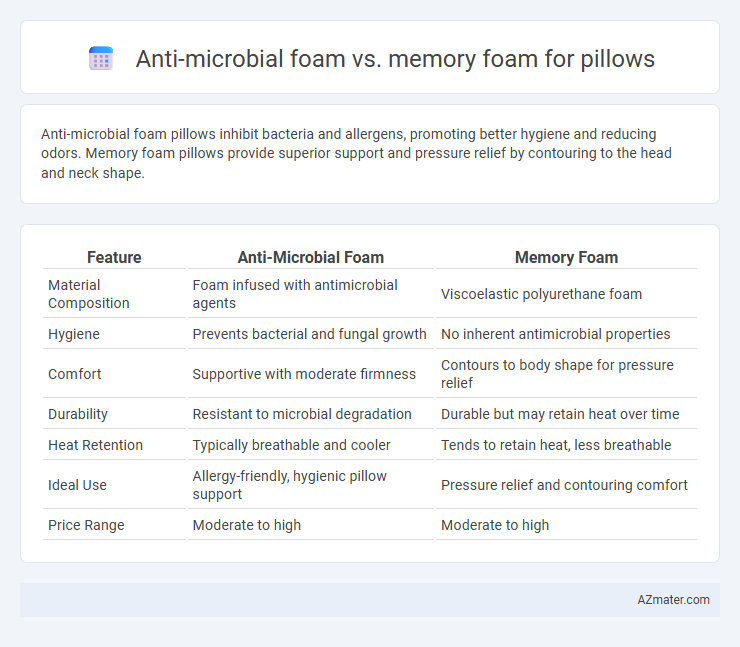Anti-microbial foam pillows inhibit bacteria and allergens, promoting better hygiene and reducing odors. Memory foam pillows provide superior support and pressure relief by contouring to the head and neck shape.
Table of Comparison
| Feature | Anti-Microbial Foam | Memory Foam |
|---|---|---|
| Material Composition | Foam infused with antimicrobial agents | Viscoelastic polyurethane foam |
| Hygiene | Prevents bacterial and fungal growth | No inherent antimicrobial properties |
| Comfort | Supportive with moderate firmness | Contours to body shape for pressure relief |
| Durability | Resistant to microbial degradation | Durable but may retain heat over time |
| Heat Retention | Typically breathable and cooler | Tends to retain heat, less breathable |
| Ideal Use | Allergy-friendly, hygienic pillow support | Pressure relief and contouring comfort |
| Price Range | Moderate to high | Moderate to high |
Introduction to Pillow Materials: Anti-Microbial Foam vs. Memory Foam
Anti-microbial foam pillow materials incorporate specialized agents that inhibit the growth of bacteria, mold, and allergens, promoting a cleaner and healthier sleep environment. Memory foam pillows are renowned for their viscoelastic properties, contouring to the sleeper's head and neck to provide superior support and pressure relief. Selecting between anti-microbial foam and memory foam depends on individual priorities such as hygiene benefits versus personalized comfort and support.
What Is Anti-Microbial Foam?
Anti-microbial foam is a specially treated material designed to inhibit the growth of bacteria, mold, and dust mites, which helps maintain a cleaner and healthier sleeping environment. Unlike memory foam, which primarily offers pressure-relieving comfort and support by contouring to the body, anti-microbial foam focuses on hygiene and allergen resistance. This makes anti-microbial foam an ideal choice for individuals prone to allergies or respiratory issues, as it helps reduce common sleep-disrupting irritants.
Understanding Memory Foam: Composition and Benefits
Memory foam, composed primarily of viscoelastic polyurethane, offers superior support by conforming to the body's shape and evenly distributing weight, which helps alleviate pressure points and improve spinal alignment. Its dense structure reduces motion transfer, making it ideal for individuals seeking undisturbed sleep. While memory foam provides enhanced comfort and durability, anti-microbial foam integrates antimicrobial agents to inhibit bacterial growth, promoting hygiene but may not offer the same contouring benefits as memory foam.
Key Differences Between Anti-Microbial Foam and Memory Foam
Anti-microbial foam incorporates agents that inhibit the growth of bacteria, mold, and dust mites, making it ideal for individuals with allergies or sensitive skin, while memory foam is primarily designed for pressure relief and conforms to the body's shape to provide personalized support. Anti-microbial foam offers enhanced hygiene benefits and odor resistance, whereas memory foam excels in contouring and reducing motion transfer during sleep. Durability and breathability can vary, with some memory foams generating heat buildup, unlike many anti-microbial foams engineered for better air circulation.
Health and Hygiene: Which Pillow Fares Better?
Anti-microbial foam pillows inhibit the growth of bacteria, dust mites, and fungi, significantly reducing allergens and maintaining a cleaner sleeping environment. Memory foam pillows, while offering excellent support and pressure relief, do not inherently possess anti-microbial properties and may harbor microbes if not regularly cleaned. In terms of health and hygiene, anti-microbial foam fares better by actively promoting a sanitary pillow surface and minimizing the risk of allergic reactions.
Comfort and Support: Evaluating Sleep Quality
Anti-microbial foam pillows offer enhanced hygiene by preventing bacterial growth, ensuring a cleaner sleep environment that can reduce allergens and skin irritations. Memory foam pillows provide superior contouring support by molding to the head and neck, promoting spinal alignment and relieving pressure points for improved sleep quality. Combining these features, some pillows utilize infused anti-microbial agents within memory foam, balancing comfort, support, and cleanliness to optimize overall sleep experience.
Durability and Longevity: A Comparative Analysis
Anti-microbial foam pillows resist bacteria and mold growth, significantly extending their lifespan by maintaining hygiene and structural integrity over time. Memory foam pillows, known for their dense and resilient composition, offer superior durability by retaining shape and support despite prolonged use. Comparative studies reveal anti-microbial foam excels in environments prone to moisture and allergens, whereas memory foam provides long-lasting comfort with consistent support, making the choice dependent on user needs for hygiene versus ergonomic durability.
Allergy Considerations: Anti-Microbial vs. Memory Foam
Anti-microbial foam pillows are engineered with materials that inhibit the growth of bacteria, mold, and allergens, making them an ideal choice for allergy sufferers prone to respiratory issues. Memory foam, while providing excellent support and pressure relief, can sometimes retain moisture and harbor dust mites unless treated with anti-microbial agents. For individuals with allergies, pillows infused with anti-microbial properties significantly reduce allergens compared to traditional memory foam options.
Environmental Impact and Sustainability
Anti-microbial foam pillows reduce bacterial growth and extend product lifespan, minimizing waste and chemical use during production, contributing positively to environmental sustainability. Memory foam pillows, derived from petroleum-based polyurethanes, have a higher carbon footprint and longer degradation period, posing challenges for eco-friendly disposal. Choosing antimicrobial foam with recyclable or biodegradable properties supports reduced environmental impact and promotes sustainable sleep products.
Choosing the Right Pillow: Which Foam is Best for You?
Anti-microbial foam pillows offer superior defense against bacteria, mold, and allergens, making them ideal for individuals with allergies or sensitive skin. Memory foam pillows provide excellent support by contouring to the head and neck, promoting proper spinal alignment and reducing pressure points during sleep. Choosing the right pillow depends on your specific needs: prioritize hygiene and allergy prevention with anti-microbial foam or focus on ergonomic comfort and support with memory foam.

Infographic: Anti-microbial foam vs Memory foam for Pillow
 azmater.com
azmater.com